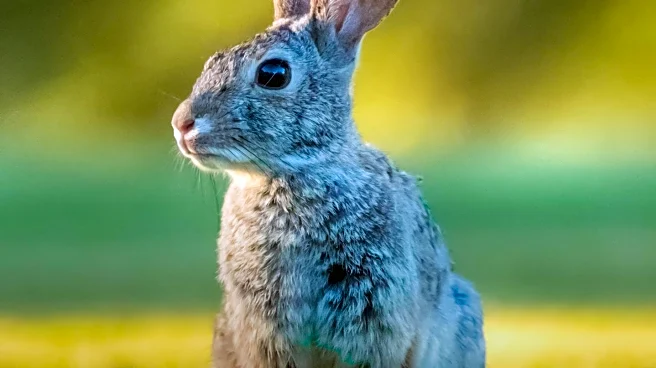Rapid Read • 8 min read
In Fort Collins, Colorado, a group of rabbits has been observed with unusual horn-like growths on their faces, a condition caused by the Shope papillomavirus. This virus, which is relatively common among rabbits, leads to wart-like protrusions that can resemble horns. The phenomenon has captured public attention, with residents sharing images and dubbing the affected animals 'Frankenstein bunnies' and 'zombie rabbits.' Despite the alarming appearance, the virus is mostly harmless to the rabbits unless the growths interfere with their ability to eat or see. The Shope papillomavirus, named after Dr. Richard E. Shope who discovered it in the 1930s, has historical significance as it contributed to the understanding of the relationship between viruses and cancer. The virus is spread by fleas and ticks, and while it can be transmitted between rabbits, it poses no threat to humans or other animals.
AD
The appearance of these 'horned' rabbits highlights the ongoing interaction between wildlife and viral diseases, which can have broader implications for ecological health and scientific research. The Shope papillomavirus is a key example of how animal diseases can inform human medical research, particularly in understanding viral links to cancer. The public's fascination with these rabbits also underscores the role of social media in spreading awareness and potentially misinformation about wildlife diseases. For wildlife management agencies, such as Colorado Parks and Wildlife, these sightings present an opportunity to educate the public about the virus and its effects, as well as to monitor the health of local wildlife populations.
Colorado Parks and Wildlife will likely continue to monitor the situation, responding to public inquiries and ensuring that the local rabbit population remains healthy. As the virus is more prevalent in warmer months due to increased flea and tick activity, wildlife officials may also focus on controlling these vectors to prevent further spread. Public education campaigns could be implemented to inform residents about the virus and its effects, reducing unnecessary alarm and promoting coexistence with local wildlife.
The Shope papillomavirus in rabbits serves as a reminder of the interconnectedness of ecosystems and the potential for animal diseases to inform human health research. The historical context of the virus, linked to the jackalope myth and cancer research, illustrates the cultural and scientific significance of such wildlife phenomena. This case also highlights the importance of maintaining biodiversity and monitoring wildlife health as part of broader environmental conservation efforts.
AD
More Stories You Might Enjoy











